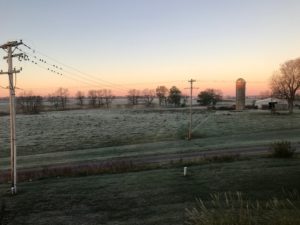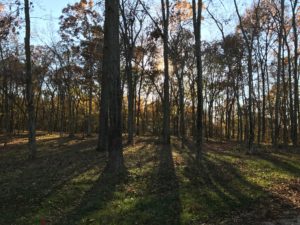Winter in the woods is nice.
Yes, it’s cold, but you can dress for the cold. Unlike during August, mud, insects, and that penetrating, hot humid air that makes you want to walk slowly are not a problem. There might be snow and ice, but usually not much that, either.

There’s also a pleasant winter sound in the woods. When the breeze stirs the stiff branches, they make a different, faintly crackling sound that is very different from the leaf rubbing sounds of the summer.
I found the main drawback to winter in the woods is the shortened day of sunlight. Less time to enjoy the outdoors before it gets dark…very dark.

I’ve discovered that some preparations need to be made before winter sets in with its hard freezes.
Gasoline tanks need to have stabilizer added to them and topped off. The gasoline won’t freeze, but it can deteriorate over the winter. I prefer full tanks of gas (in the Gator, the generator, and the chain saw) to discourage condensation.
Plastic water tanks need to be drained, and the reservoir to the sprayer tanks drained. As water freezes, it expands. Depending on the tank geometry, this expansion can crack to tank.
I discovered the hard way that in addition to draining the sprayer tanks, it is a good idea to drain the sprayer tubing and control nozzle, and leave it open to the air. Last spring, I decided to get in some early invasive species spraying with Roundup. I loaded up my sprayer tank in the back of the Gator, connected the electrical supply to the pump, and headed off for the first invasive I could find. As soon as I squeezed the nozzle control, I learned an important lesson.
Water and herbicide began flying explosively out of the handle, not out of the nozzle. I didn’t get soaked, and none of it got in my eyes or mouth, but it could have. On close inspection, I saw that the handle of the sprayer nozzle was fractured, presumably because I hadn’t drained the water out of it over the winter. The sprayer was inoperable, and I was covered with herbicide. I headed into town to regroup.
After showering and changing clothes, I made a run to the John Deere dealer where I had purchased the sprayer, hoping they would have a spare part that would solve the problem. Of course, they had the part, but it would have to be ordered and would arrive in several days, long after I had returned home.
Next, I visited Buckheit’s, a big-box style rural supply house not far from my woods. They didn’t carry spare sprayer handles (apparently, everyone else knows to drain the hoses before winter sets in.), but they did carry a smaller, relatively inexpensive sprayer and tank that I could use as a backup to my big tank (for the next time I forget to drain the hoses before a hard freeze).
After spending half a day messing with this, I finally was back in the spraying business.
Note to self: Please remember to drain all the hoses before closing up for the winter.
